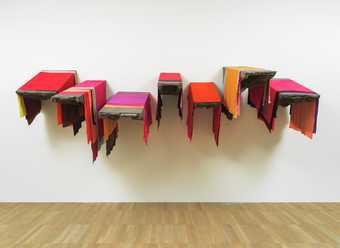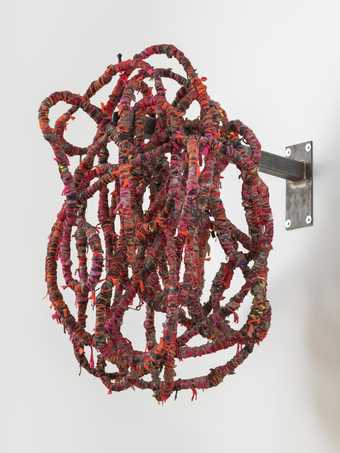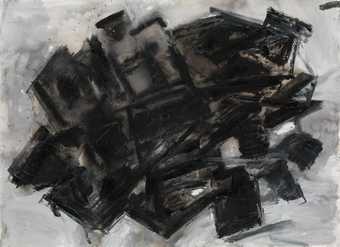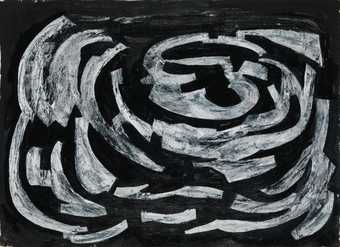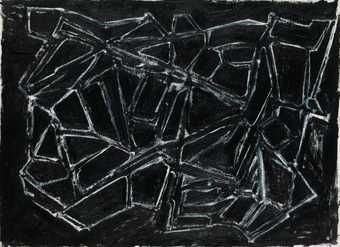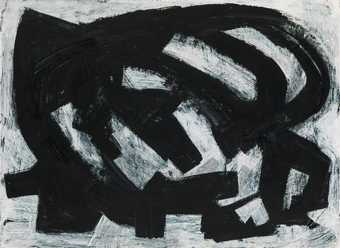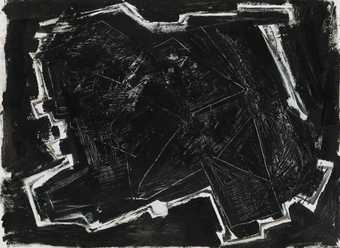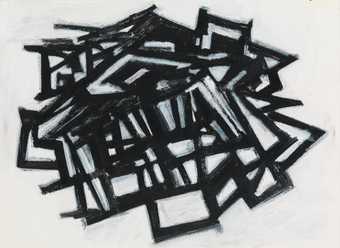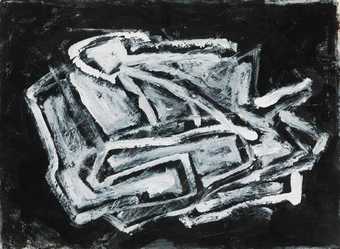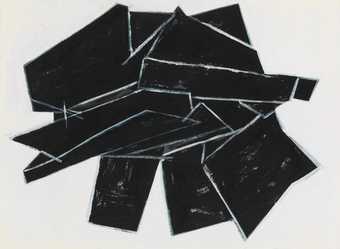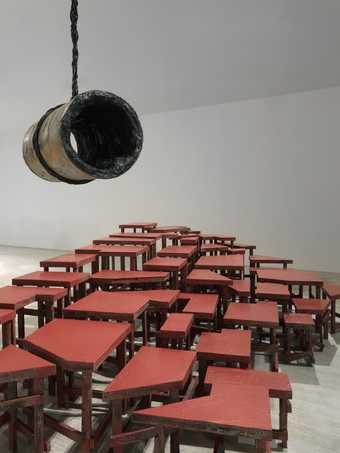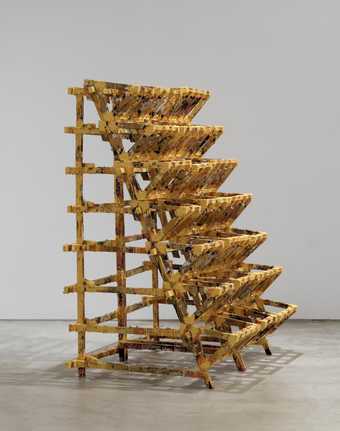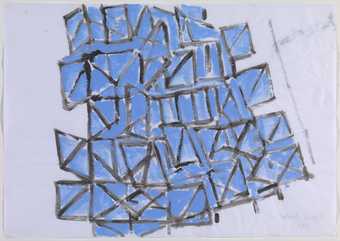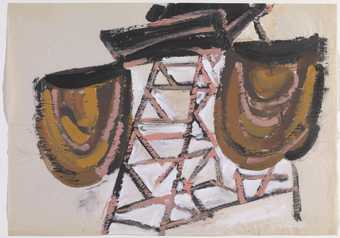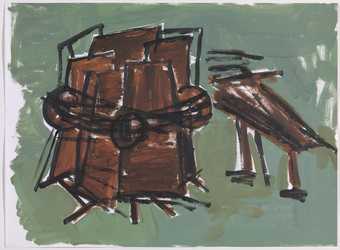Not on display
- Artist
- Dame Phyllida Barlow DBE RA 1944 – 2023
- Medium
- Softwood, plywood, hardboard, steel, expanded polyurethane foam, cement render and paint
- Dimensions
- Object: 5000 × 4750 × 3225 mm
- Collection
- ARTIST ROOMS Tate and National Galleries of Scotland
- Acquisition
- ARTIST ROOMS Tate and National Galleries of Scotland. Presented by the artist and acquired with assistance from the ARTIST ROOMS Fund, supported by the Henry Moore Foundation and Tate Members 2015
- Reference
- AR01228
Summary
untitled: upturnedhouse2, 2012 2012 is a large-scale sculpture by Phyllida Barlow. The structure is made of wood, steel, polyurethane foam and cement with a surface comprising multiple panels. This enclosure-like shape appears to balance jauntily on a stack of wooden wedges made to resemble concrete, while blocks and planes also jut from the sides of the work. The panels are painted in different colours in a bold palette of intense reds and yellows combined with softer hues of pink and grey, with the inclusion of black at intervals so as to break up any sense of colour synchrony. With one corner raised in the air, the work looks as if it could possibly collapse or tip over, hardly finding its balance on the wedges that purportedly keep it in place. The title of the work – as is typical in Barlow’s practice – is an ‘all-in-one’ compound word that points to a functional structure (a house) that has been abstracted from its initial form and purpose to become an object of display now devoid of any function.
The work is representative of Barlow’s approach to sculpture, which is characterised by the use of inexpensive and readily available materials that she transforms through processes of layering, accumulation and juxtaposition. The artist has described her own work variously as consciously ‘Big Bad [and] Ugly’ and as ‘wordless, wild, messy, unpredictable, ugly, difficult’ (quoted in Godfrey and Wood 2004, pp.53, 63). Since the late 1960s Barlow has focused on the physical experience of handling materials, which she transforms through processes of layering, accumulation and juxtaposition. Obtrusive and invasive, Barlow’s large-scale sculptural objects are frequently arranged in complex installations in which mass and volume seem to be at odds with the space around them. Their presence is restless and unpredictable: they block, interrupt, intervene, straddle and perch in the exhibition space, both dictating and challenging the experience of viewing. Household materials, such as carpets, sheets, cardboard and ropes, are often combined with DIY materials such as foam, Formica, polystyrene, concrete and timber, held together through different actions such as cutting, slicing, sawing, breaking or wrecking, as well as coiling, folding, wrapping or covering. Rather than employing traditional sculptural working methods like carving or welding, Barlow’s work is characterised by accumulation and arrangement. Through an unmediated physical encounter with the materials, she manipulates structures and builds up surfaces.
In the early 1990s Barlow began to work with arrangements and groupings of sculptures, focusing on ‘the space between the objects and what that did to an audience, how the audience moved around the works and discovered each one of them’ (the artist in conversation with curator Pippa Coles in Coles and Fabrizi 2004, p.47). This interest in the dynamic between her works themselves, and between them and the viewer, has been a continuing theme in her practice ever since. Talking about the relationship established between the work and the audience in the exhibition space, the artist has noted:
Initially the audience is myself. How I’m physically negotiating the space is often more important than the object itself. They are obstacles to be navigated, protagonists that I feel I’m encountering. The private view consequently comes as a terrible shock, because here are all these people who are there to use the space. It feels extraordinary that the audience are being allowed on the stage and are somehow grabbing the script from me!
(Quoted in Oliver Basciano, ‘Feature: Phyllida Barlow’, Art Review, no.39, March 2010, p.72.)
Further reading
Mark Godfrey and Jon Wood, Objects For … And Other Things: Phyllida Barlow, London 2004.
Pippa Coles and Elisabetta Fabrizi (eds.), Phyllida Barlow: Peninsula: A New Baltic Commission, exhibition catalogue, BALTIC Centre for Contemporary Art, Gateshead 2004.
Phyllida Barlow: Street, exhibition catalogue, BAWAG Contemporary, Vienna 2010.
Carmen Juliá
July 2014
Revised October 2014
Does this text contain inaccurate information or language that you feel we should improve or change? We would like to hear from you.
You might like
-
Dame Phyllida Barlow DBE RA untitled: awnings, 2012
2012 -
Dame Phyllida Barlow DBE RA untitled: torque, 2015
2015 -
Dame Phyllida Barlow DBE RA untitled: black 1, 2014
2014 -
Dame Phyllida Barlow DBE RA untitled: black 2, 2014/2015
2014–5 -
Dame Phyllida Barlow DBE RA untitled: black 3, 2014
2014 -
Dame Phyllida Barlow DBE RA untitled: black 4, 2014
2014 -
Dame Phyllida Barlow DBE RA untitled: black 7, 2015
2015 -
Dame Phyllida Barlow DBE RA untitled: black 9, 2015
2015 -
Dame Phyllida Barlow DBE RA untitled: black 10, 2015
2015 -
Dame Phyllida Barlow DBE RA untitled: black 11, 2014
2014 -
Dame Phyllida Barlow DBE RA untitled: brokenstage/hangingcontainer, 2012/2013
2012–3 -
Dame Phyllida Barlow DBE RA Untitled (Yellow Rack)
2006 -
Dame Phyllida Barlow DBE RA Untitled
1997 -
Dame Phyllida Barlow DBE RA Untitled
1999 -
Dame Phyllida Barlow DBE RA Untitled
2003


